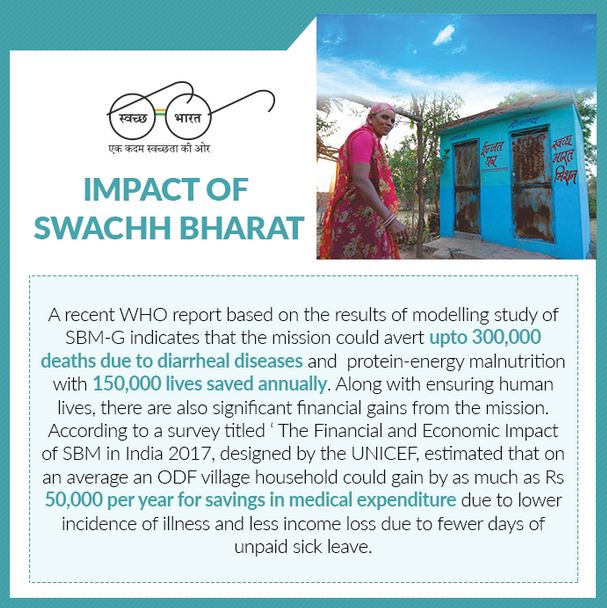Note4Students
From UPSC perspective, the following things are important :
Mains level: Effectiveness of Swachh Bharat Mission;
Why in the News?
A new study published in the peer-reviewed “journal Nature” has found that the construction of toilets under the government’s “Swachh Bharat Mission” helped prevent approximately 60,000 to 70,000 infant deaths annually between 2011 and 2020.
Key Highlights of the Report:
- Impact of SBM: The study revealed that districts with over 30% toilet coverage under SBM experienced reductions of 5.3 in the Infant Mortality Rate and 6.8 in the Under Five Mortality Rate per thousand live births.
- Over 9.5 crore toilets being built across the country since 2014;
- 564,658 villages being declared Open Defecation Free (ODF);
- 30 States/UT’s being 100% covered with individual household latrines (as of 2019).
- Unique Approach of SBM: The approach of combining toilet construction with substantial investments in IEC (Information, Education, and Communication) and community engagement represents a marked departure from traditional efforts in India.
- Novel Evidence of Impact: The study provides novel evidence of reductions in infant and child mortality following SBM’s comprehensive national sanitation program, indicating its transformative role in improving public health outcomes.
- Asian Enigma: The report touches on the “Asian Enigma,” which highlights persistently high levels of undernutrition and stunting among children despite sufficient food availability, linking it to poor sanitation practices and open defecation.

Successful Journey since Inception (2014-present):
- Phase I (2014): The SBM 1.0 aimed to make urban centers open-defecation-free and improve sanitation infrastructure, particularly toilets.
-
- The mission targeted constructing household, community, and public toilets, converting insanitary latrines, and improving solid-waste management.
-
- Phase II (2020): The SBM 2.0 commenced in 2020, and is expected to run till 2025-26. It aims to sustain the achievements of phase I and ensure that treatment of both liquid and solid waste is achieved through the help of technology and private sector engagement.
- This will focus on making Indian cities garbage-free by improving scientific waste management systems.
Way forward:
- Global Model for Sanitation: India’s national sanitation campaign under SBM could serve as a model for other low- and middle-income countries where sanitation remains a major public health challenge.
- Focus on Behavioral Change: Alongside infrastructure development, efforts are needed to sustain behavioural changes to eliminate open defecation.
- Expand Sanitation Infrastructure in Rural Areas: Prioritize extending sanitation coverage and scientific waste management systems to underserved rural regions, building on the success of SBM to reduce mortality further and improve public health.
Get an IAS/IPS ranker as your 1: 1 personal mentor for UPSC 2024
